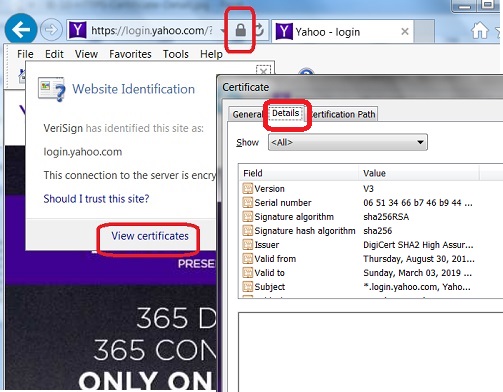PKI Tutorials - Herong's Tutorial Examples - v2.32, by Herong Yang
Viewing Server Certificate Details in IE
This section provides a tutorial example on how to view certificate details when visiting an 'https' Website in IE.
When you visit a "https" Web server, it will send its certificate to your browser. Server's certificate is needed by the browser for 2 reasons:
- Your browser must validate the certificate to determine that the Website can be trusted or not before doing any further communications.
- Your browser must use the public key in the certificate to help secure the communication messages sent and received.
Normally, your browser will do these 2 tasks automatically without your interaction. You don't need to know where is the server certificate and what's in the certificate.
But since I am interested to learn more about "https" communication, I want to see the server certificate. Here is what did on IE to see details of the server certificate.
1. Run IE and go to https://login.yahoo.com and wait for the log in page to be displayed.
2. Click the lock icon at the end of the Web address field. A small pop up windows shows up.
3. Click the "View certificates" link on the pop up window. The Certificate dialog box shows up. The General tab tells me this information:
This certificate is intended for the following purpose(s): * Ensures the identify of a remote computer Issued to: *.login.yahoo.com Issued by: DigiCert SHA2 High Assurance Server CA Valid from 8/30/2018 to 3/3/2019
4. If you click the Details tab, you will details of this certificate:
Version V3 Serial number 06 51 34 66 b7 46 b9 44 a0 c6 99 7c f5 63 a8 1d Signature algorithm sha256RSA Issuer DigiCert SHA2 High Assurance Server CA Valid from Thursday, August 30, 2018 8:00:00 PM Valid to Sunday, March 03, 2019 8:00:00 AM Subject *.login.yahoo.com Public key RSA (2048 Bits) ...
Cool. Now I see details of a real server certificate for commercial uses. The picture below shows you steps to see certificate details:

Table of Contents
Introduction of PKI (Public Key Infrastructure)
Introduction of HTTPS (Hypertext Transfer Protocol Secure)
Using HTTPS with Google Chrome
Using HTTPS with Mozilla Firefox
►HTTPS with IE (Internet Explorer)
Visiting "https" Website with IE
►Viewing Server Certificate Details in IE
Viewing Server Certificate Path in IE
Installing Server Certificate Permanently in IE
Viewing Certificates in Certificate Stores in IE
Listing of Trusted Root CA in IE
Exporting Certificate to File from IE
Saving Server Certificate to File with IE
IE Supporting Multiple Certificate Paths
IE Reinstalling Root Certificates Automatically
Windows Automatic Root Update Mechanism
Android and Server Certificate
Windows Certificate Stores and Console
RDP (Remote Desktop Protocol) and Server Certificate
macOS Certificate Stores and Keychain Access
Perl Scripts Communicating with HTTPS Servers
PHP Scripts Communicating with HTTPS Servers
Java Programs Communicating with HTTPS Servers
.NET Programs Communicating with HTTPS Servers
CAcert.org - Root CA Offering Free Certificates
PKI CA Administration - Issuing Certificates
Comodo Free Personal Certificate
Digital Signature - Microsoft Word
Digital Signature - OpenOffice.org 3